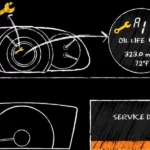Ever wondered what makes the L98 engine tick? Whether you’re a car enthusiast looking to understand the heart of your Holden or Corvette, or just curious about this iconic powerplant, you’re in the right place. The L98 designation has been used for two distinctly different GM V8 engines throughout automotive history, and we’re diving deep into both.
The Two Faces of the L98 Engine
The L98 name has graced two very different engines:
- A 6.0L Gen IV aluminum block V8 used in Australian Holden vehicles (2006-2010)
- A 5.7L (350 cubic inch) small block V8 used in American performance cars like the Corvette C4 (1985-1991)
Let’s explore both, starting with the more recent Australian version.
Gen IV 6.0L L98: The Australian Powerhouse
The 6.0L L98 is essentially an L76 engine with the Active Fuel Management hardware removed. This modification created a simpler, more robust powerplant specifically for Holden’s performance vehicles.
Core Engine Specs
| Specification | Details |
|---|---|
| Displacement | 6.0L / 5967cc / 364 cubic inches |
| Block & Head Material | Cast aluminum |
| Bore × Stroke | 101.6mm × 92.0mm (4.00″ × 3.62″) |
| Compression Ratio | 10.4:1 |
| Valvetrain | OHV, 2 valves per cylinder |
| Maximum Engine Speed | 6500 RPM |
| Power Output | 270 kW (362 hp) @ 5700-6000 RPM |
| Torque | 530 Nm (391 lb-ft) @ 4400 RPM |
What makes the L98 particularly interesting is how it compares to its cousin, the LS2. While the stock L98 produces less power than the LS2 due to a more conservative camshaft, when equipped with identical cams, the L98 actually outperforms the LS2 thanks to its superior head flow characteristics.
Fuel System and Induction
The L98 uses a sophisticated fuel delivery system:
- Sequential port fuel injection
- 90mm (3.55-inch) electronic throttle body
- Premium fuel recommended (later models can use E85)
- 42 lb/hr fuel injectors running at 58 psi
Cylinder Head Design: A Key Advantage
One of the L98’s standout features is its cylinder head design with “823” casting numbers. These heads feature:
- Rectangular intake ports (shared with the later LS3 V8)
- D-shaped exhaust ports
- 70cc combustion chambers
- Beehive valve springs
- 1.7 ratio roller-pivot rocker arms
This head design is part of what gives the L98 its impressive performance potential.
Camshaft: Conservative But Effective
The L98 camshaft specs include:
- Valve lift: 0.478-inch intake / 0.466-inch exhaust
- Duration: 196° intake / 208° exhaust (at 0.050-inch tappet lift)
- Lobe separation angle: 116 degrees
While these specs are milder than the LS2’s camshaft, they provide excellent everyday drivability while still delivering strong performance.
Vehicles Featuring the Gen IV L98
The 6.0L L98 engine powered various Holden models in Australia:
- 2006-2007: Holden SS Thunder Ute (349 hp / 260 kW)
- 2006-2009: Holden Calais, Statesman, Caprice (362 hp / 270 kW)
- 2006-2010: Holden Commodore SS, Sportwagon SS, Ute SS
- 2007-2010: Holden Ute
These vehicles were typically paired with either a T-56 six-speed manual transmission or a 6L80 six-speed automatic transmission, making them versatile performance machines.
Modifying the 6.0L L98: Untapped Potential
The L98 responds exceptionally well to modifications. Here are some popular upgrades:
- Cam Upgrade: One of the most cost-effective power improvements
- Headers and Exhaust: Helps the engine breathe better
- Cold Air Intake: Improves airflow into the engine
- Tuning: Optimizes fuel and timing maps for more power
With these modifications, owners can easily push their L98 engines well beyond 400 horsepower.
The Classic 5.7L L98: America’s Performance V8
Before the Australian 6.0L version, the L98 name was used for the 5.7L (350 cubic inch) small-block V8 that powered the Corvette C4 and other GM performance cars from 1985 to 1991.
5.7L L98 Specifications
| Specification | Details |
|---|---|
| Displacement | 350 cubic inches (5.7L) |
| Bore × Stroke | 4.00″ (101.6 mm) × 3.48″ (88.39 mm) |
| Compression Ratio | 9.0:1 – 10.0:1 (varied by year) |
| Horsepower | 230-250 hp @ 4,000 rpm |
| Torque | 330-350 lb-ft @ 3,200 rpm |
This engine was significant as it introduced Tuned Port Injection (TPI) to the Corvette lineup, replacing the Cross-Fire Injection system used in earlier C4 models. The TPI system featured long intake runners that enhanced torque at lower RPMs, making the L98 Corvette feel muscular during everyday driving.
5.7L L98 Evolution Through the Years
The original L98 saw several improvements during its production run:
- 1985: Introduced with 230 hp, 330 lb-ft of torque
- 1986: Power increased to 235 hp with minor refinements
- 1987: Roller hydraulic camshaft added, power up to 240 hp
- 1989-1991: Final versions reached 245-250 hp with 340-350 lb-ft of torque
While these numbers may seem modest by today’s standards, the L98 was a significant performer in its era.
L98 vs. LS Engines: Understanding the Differences
Many people confuse the L98 with various LS engines, so let’s clarify:
- The 6.0L L98 is part of the Gen IV family, related to the LS2 and LS3
- It shares the basic architecture of LS engines but has unique features
- The 5.7L L98 predates the LS series entirely, belonging to the traditional small-block family
- The LS1 replaced the last generation of traditional small-blocks in the 1990s
The 6.0L L98 essentially bridges the gap between the LS2 and LS3 designs, incorporating elements of both while maintaining its own distinct character.
Common Issues and Reliability
Both L98 engines are known for their robust design, but they do have some known issues:
6.0L L98 Potential Issues:
- Oil consumption in high-mileage engines
- Valley plate gasket leaks
- Lifter wear (less common than in AFM-equipped engines)
5.7L L98 Potential Issues:
- Intake manifold gasket leaks
- Distributor problems
- Optispark failure (in later years)
Despite these occasional concerns, both engines are generally considered quite reliable, with many examples still running strong after hundreds of thousands of miles.
Performance Comparisons: How Does the L98 Stack Up?
To put the L98 in perspective, let’s compare it to some contemporary engines:
6.0L L98 vs. Competitors (2006-2010)
- L98: 362 hp, 391 lb-ft
- Ford 5.4L Modular: 300 hp, 365 lb-ft
- Chrysler 6.1L Hemi: 425 hp, 420 lb-ft
5.7L L98 vs. Competitors (1985-1991)
- L98: 230-250 hp, 330-350 lb-ft
- Ford 5.0L HO: 225 hp, 300 lb-ft
- Chrysler 5.9L Magnum: 230 hp, 325 lb-ft
In both eras, the L98 was competitive, offering a good balance of power, torque, and reliability.
Production History and Legacy
The L98 engine has left a meaningful mark on automotive history in two distinct periods:
- 5.7L L98 (1985-1991): Powered the C4 Corvette during a transitional era for GM, bringing fuel injection and computer control to their flagship sports car.
- 6.0L L98 (2006-2010): Served as the heart of Holden’s performance lineup in Australia, creating some of the most beloved Aussie muscle cars ever made.
Today, both engines have cult followings, with enthusiasts appreciating their combination of performance potential, reliability, and relative simplicity.
Finding and Identifying an L98 Engine
If you’re looking for an L98 engine or trying to confirm what’s in your vehicle, here are some identification tips:
6.0L L98 Identification
- Look for the 823 casting number on cylinder heads
- Engine code on the block should include “L98”
- VIN decoder for Holden vehicles will confirm the engine type
5.7L L98 Identification
- Look for “L98” stamped on the engine
- Check for the distinctive Tuned Port Injection setup
- 1985-1991 Corvettes and some Camaros/Firebirds came with this engine
These identification methods can help you verify the authenticity of an L98 engine.
Swapping and Engine Compatibility
The L98 engines make great swap candidates for project cars. Here’s what you need to know:
6.0L L98 Swap Considerations
- Uses standard LS mounting patterns and accessories
- Compatible with most LS transmissions
- Computer/wiring is similar to other Gen IV engines
- May need different oil pan depending on application
5.7L L98 Swap Considerations
- Uses standard small block Chevy mounting patterns
- Works with most GM transmissions of the era
- TPI system is tall – check for hood clearance
- Computer system is older but still manageable
With the right preparation, either L98 can make a great heart for a project vehicle.
The Lasting Impact of the L98
The L98 engines, despite sharing a name, represent two very different chapters in GM’s V8 history. The original 5.7L version helped bridge the gap between carbureted engines and modern fuel injection, while the later 6.0L Australian version showed how GM could tailor its global engine architecture for specific markets and applications.
Both engines have earned their places in automotive history, powering memorable performance vehicles and creating loyal followings. Whether in a Corvette cruising American highways or a Holden Commodore tearing up Australian roads, the L98 name has come to represent solid, reliable performance with excellent potential for enhancement.
For enthusiasts and collectors, vehicles equipped with either L98 variant continue to be desirable additions to any garage, representing important steps in the evolution of GM’s performance engines.




